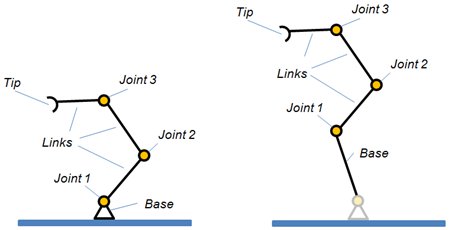Basics on IK groups and IK elementsCoppeliaSim uses IK groups and IK elements to solve inverse and forward kinematics tasks. It is important to understand how an IK task is solved in order to take full advantage of the kinematics functionality in CoppeliaSim. Make sure to have a look at the various example scenes related to IK and FK in folder scenes/kinematics. An IK task is defined by an IK group, which contains one or more IK elements: Following figures show two kinematic chains as they are described via IK elements. The two IK elements perceive the two chains in a similar way (the very first joint of the second example is ignored by the IK element):
[Two kinematic chains, each describing an IK element] The goal of an IK element (i.e. resolution of an IK element) is to have the target followed by the tip (i.e. having tip and target overlap, given certain constraints), by computing the appropriate joint values for the kinematic chain:
[IK element and corresponding model of the IK solving task] In above example (in 2D for simplicity), we can specify various constraints for the tip-target pair, e.g.: Note that even for the most basic IK task, an IK element is solved via the resolution of the encompassing IK group. Two separate kinematic chains are handled in an identical fashion, however this time, two IK groups are needed (and each one of them should contain one IK element for each kinematic chain). Solving order of the two IK groups is usually not important:
[Two separate IK chains and corresponding model of the IK solving tasks] In above example, should target2 be attached to a mobile part of the first kinematic chain, then the solving order becomes important and the IK group1 should be solved first (solving result will displace target2 as can be seen from following figure):
[Two separate IK chains, where the target of the second chain is attached to the first chain, and corresponding model of the IK solving tasks] A similar case can appear when one IK element is built on top of another IK element, without sharing any common joint as can be seen from following figure: the first kinematic chain is indicated in black, the second in light blue. Base2, indicated in purple, is the common object between the two chains. Solving IK element2 won't displace the purple link, however solving IK element1 will displace it. For that reason IK group1 has to be solved before IK group2 as in above case (solving order is important):
[Two IK chains sharing one common link but no common joints and corresponding model of the IK solving tasks] A more difficult case appears when two or more kinematic chains share common joints. In that case sequential solving doesn't work most of the time (in following example, the two IK elements tend to rotate the common joint into opposite directions) and a simultaneous solving method is needed. To simultaneously solve several IK elements, just group them into one common IK group. This case is illustrated in following figure:
[Two IK chains sharing one common joint and corresponding model of the IK solving task] |






